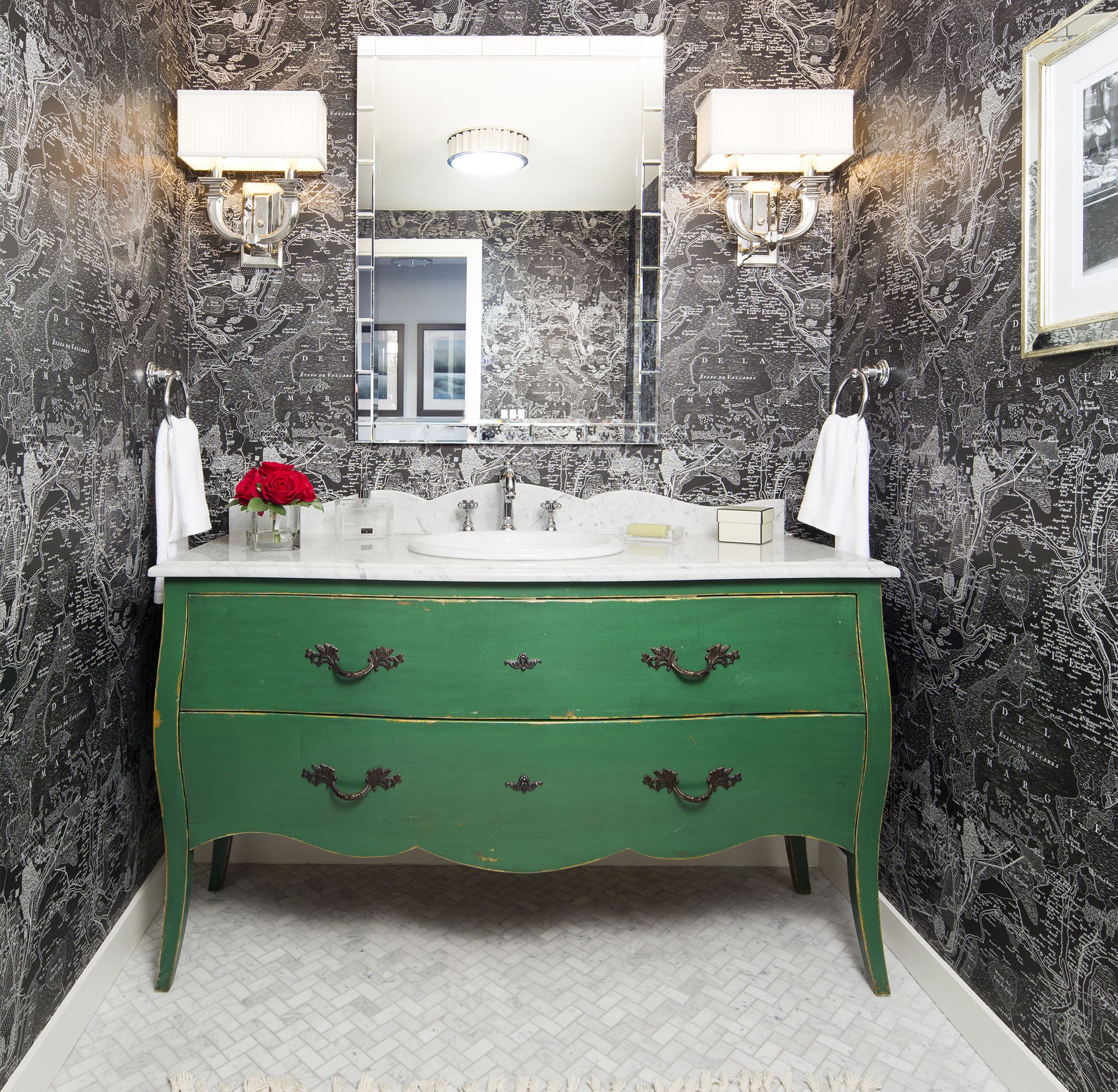Turning a dresser into a bathroom vanity is a challenging but rewarding do-it-yourself (DIY) project. It requires some carpentry skills and plumbing knowledge, but with patience and attention to detail, you can create a one-of-a-kind vanity that adds charm to your bathroom. Learn how with our step-by-step instructions below.
Tools to Make a Vanity
Before starting your project, make sure you have these tools:
 Clamps
Clamps Circular trim saw
Circular trim saw Oscillating multi-tool
Oscillating multi-tool Tape measure
Tape measure Straightedge
Straightedge Pencil
Pencil Rafter square
Rafter square Sliding T-bevel
Sliding T-bevel Miter saw
Miter saw Table saw
Table saw Pneumatic brad nailer
Pneumatic brad nailer Glue brush
Glue brush Studfinder
Studfinder Jigsaw
Jigsaw Hammer
Hammer Flat pry bar
Flat pry bar
Turning Your Dresser Into a Bathroom Vanity
Turning a dresser into a bathroom vanity involves several key steps, from selecting the right piece to making necessary modifications. Here’s what to do.
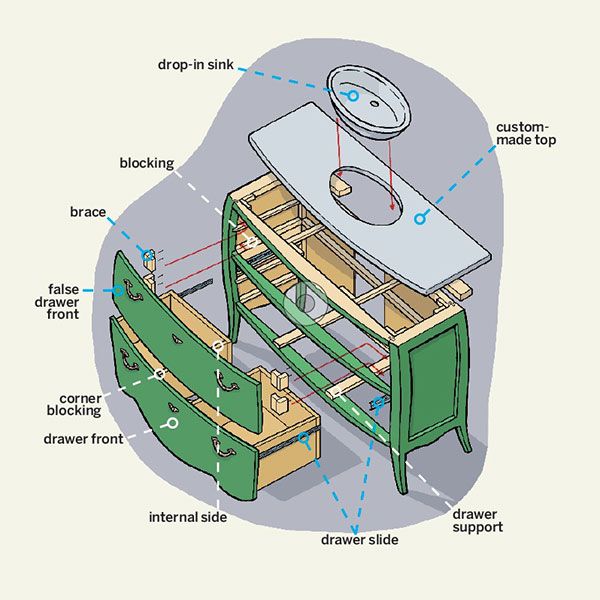
1. Cut the Drawer Sides
Begin by preparing the dresser. The top drawer often needs to be removed to accommodate the sink.
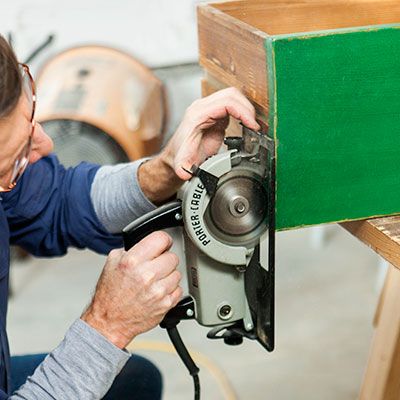
Remove the upper drawer and clamp it to a work surface. Use a trim saw or handsaw to carefully cut along the sides of the drawer where they meet the face.
This step allows you to create a false front later, maintaining the dresser’s original appearance.
2. Cut the Drawer Bottom
After addressing the sides, focus on separating the drawer bottom from the front.
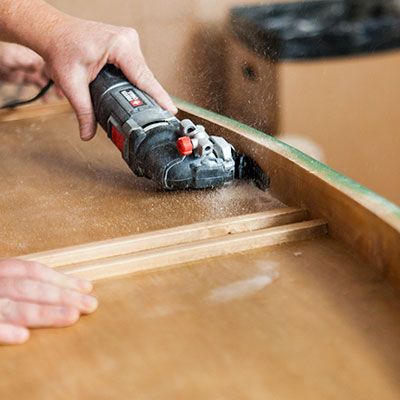
Flip the drawer upside down and use an oscillating multi-tool with a flush-cutting blade or a handheld flush-cutting saw. Cut along the back side of the drawer front where the bottom meets it. Keep the blade snug against the drawer front for a clean cut.
Set aside the drawer front and frame parts for later use, and unscrew the dresser top using a drill/driver.
3. Mark the Lower Drawer
To accommodate plumbing, you’ll need to create a cutout in at least one of the lower drawers.
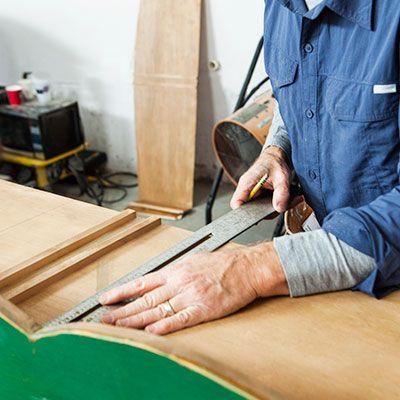
Place the drawer upside down on your work surface, and measure and mark spots 4 inches to the right and left of the drawer’s centerline. Use a straightedge to draw cutlines on the bottom of the drawer. Transfer these marks to the back of the drawer for a complete outline.
4. Cut the Drawer
With the drawer marked, it’s time to make the necessary cuts for plumbing access.
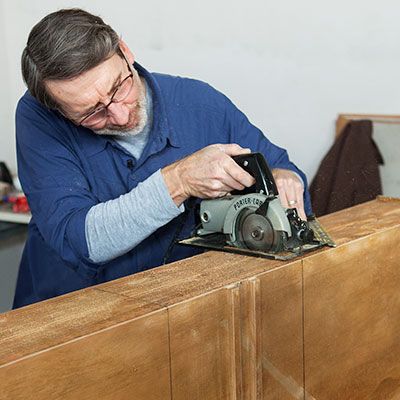
Clamp the drawer securely to your work surface. Using a rafter square as a guide, follow the cutline along the back of the drawer with a trim saw.
Continue cutting along the bottom of the drawer until you reach the face. Use a multitool or handsaw to complete the cut where it meets the drawer face.
5. Cut the Internal Sides
Creating internal supports will help maintain the drawer’s structure after the cutout.
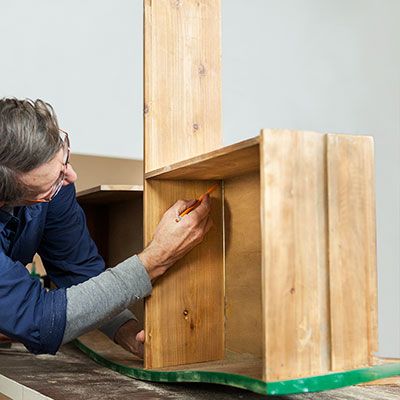
Take the upper drawer’s back and use a sliding T-bevel to find the angle where it meets the front. Transfer this angle and cut the end of the piece. Hold the cut piece upright in the cutout and mark where it intersects with the back of the lower drawer. Cut the piece on a miter saw and repeat for the opposite side.
6. Attach the Internal Sides
Secure the newly cut internal sides to reinforce the modified drawer structure.

Dry-fit the cut pieces to ensure proper placement. Apply wood glue along the edges where they will attach. Secure the pieces with a pneumatic nail gun and 1 1/4-inch, 18-gauge brads. Wipe away any excess glue with a damp cloth for a clean finish.
7. Add the Corner Blocking
Reinforce the corners of the modified drawer for added stability.
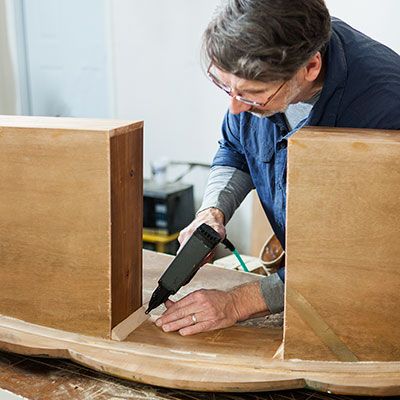
Rip angled blocking from 1x stock on a table saw. Apply wood glue to the right-angle edges of the blocking. Position the blocking between the drawer sides and face. Tack the blocking in place with brads or small nails.
Tip: If you don’t have a table saw, make corner blocking from cove or quarter-round molding.
8. Cut the Slide Blocking
Prepare the dresser frame for updated drawer slides if desired.
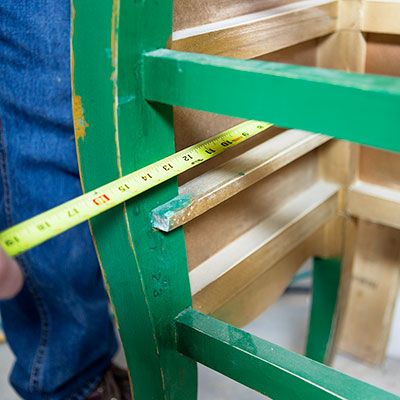
Measure between the front and back of the dresser frame just above the wooden guide. Cut a 1-by-4 to this length for each side of the dresser. These pieces will serve as blocking for heavy-duty drawer slides.
9. Install the Slide Blocking
Secure the slide blocking to provide a stable base for new drawer slides.

Add spacers if needed to fill any gaps between the blocking and dresser frame. Wedge the cut 1-by-4 blocking between the leg framing above the old wooden guides. Toenail the ends of the blocking into the framing for security. Remove the old wooden drawer guides with a hammer and pry bar.
10. Set the Drawer Rail
Install the new drawer slides for smooth operation.
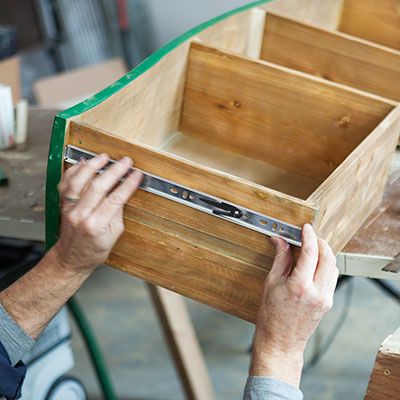
Follow the slide’s installation instructions to position the inner rail against the drawer side. Ensure the hardware is square to the back of the drawer, and mark the screw holes.
Secure the rail to the drawer with the included screws. Repeat the process on the other side of the drawer.
11. Secure the Slide to the Dresser
Attach the corresponding slide components to the dresser frame.
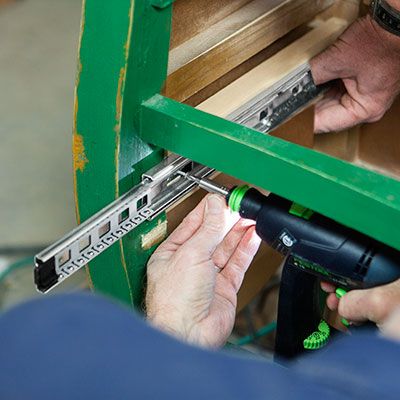
Measure and mark the position for the slide track according to the manufacturer’s instructions. Extend the slide rail to access the screw holes. Hold the track in place and fasten one side with an included screw. Square up the track before driving the remaining screws. Install the slide on the opposite side following the same steps.
12. Add the Drawer Supports
Reinforce the dresser frame to support the modified drawer.
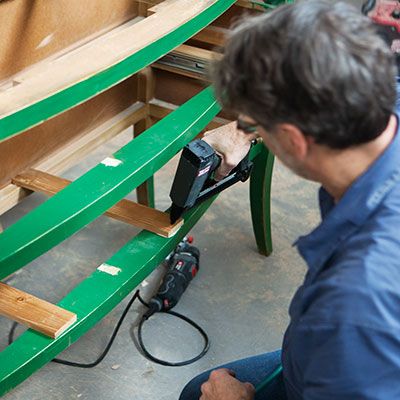
Remove the center drawer guide from the bottom of the dresser frame. Cut two pieces of 1/2-inch-thick scrap wood to connect the front and back of the dresser frame. Position the supports to be flush with the front edge and rest on the back of the frame. Glue the supports in place and secure them with 1 1/4-inch brads.
13. Make the Face Braces
Create L-shaped braces to reattach the upper drawer face.
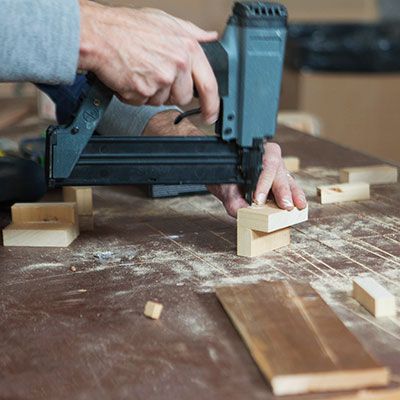
Cut 3-inch pieces of 1-by-2 and glue them together in an L-shape. Secure the L-shaped pieces with 1-inch brads. Make four braces, two for each side of the drawer face.
14. Attach the Face
Reattach the upper drawer face to maintain the dresser’s original appearance.
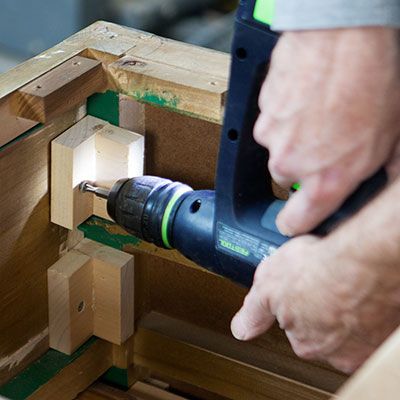
Hold the upper drawer face in place on the dresser. Position a brace in the corner where the face meets the dresser frame. Tack the brace to the frame and drill a pilot hole through the brace into the drawer face. Secure the face with 1-inch wood screws. Install the remaining braces and slide the lower drawer into place.
15. Secure the Piece
Anchor the vanity to ensure stability and safety in the bathroom.

Position the vanity in the bathroom, leaving about 3 inches of space from the wall. Locate wall studs using a stud finder and mark their positions. Cut two pieces of 2-by-4 scrap to use as mounting blocks. Align the scrap with the stud marks and screw through the back of the vanity into each 2-by-4. Push the vanity against the wall, drill angled pilot holes through each 2-by-4 into the wall studs, and secure with 3-inch wood screws.
16. Trim the Sink Hole
Modify the dresser frame to accommodate the sink if necessary.
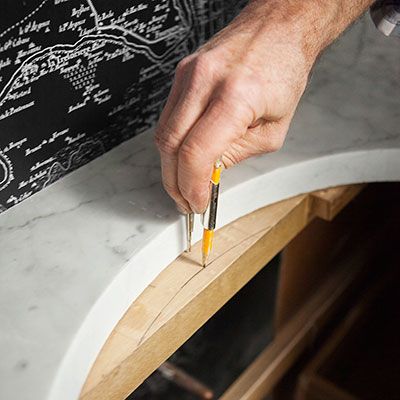
If your installation requires a curved cut in the dresser frame’s cross support, use a compass to mark the cutline. Set the compass to the width of the sink rim and trace around the opening. Use a jigsaw to carefully follow the marked line and create the necessary opening.
17. Install the Sink
Complete the transformation by installing the sink and plumbing fixtures.
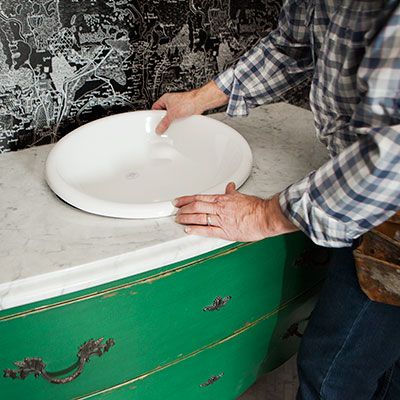
Dry-fit the sink in the countertop opening to ensure proper fit. If adjustments are needed, remove the sink and trim the crosspiece further. Once the fit is correct, apply a bead of silicone caulk to the underside of the sink’s perimeter.
Press the sink into place firmly. Install the drain and faucet according to the manufacturer’s instructions. Make the final plumbing connections to complete the installation.
Tip: To make installation easier, attach your fixtures before dropping the sink in.
Customizing Your Dresser Vanity
Beyond the basic steps of converting a dresser into a vanity, there are several ways to customize your project. Consider the following:
- Paint or refinish the dresser to match your bathroom decor.
- Replace drawer pulls with modern hardware for an updated look.
- Add a backsplash behind the vanity for extra protection and style.
- Install a vessel sink on top of the dresser for a more dramatic effect.
Consider adding luxurious touches to further elevate the vanity’s appearance. For instance, you might choose ornate faucets, crystal drawer pulls, or a marble countertop. These details not only enhance the look but also add longevity by using quality materials. Additionally, integrating storage solutions such as built-in organizers can make your vanity both stylish and practical.
Dresser Vanity Maintenance Tips
To ensure your new dresser vanity stands the test of time, do the following:
- Regularly check for water damage and address any issues promptly.
- Apply a water-resistant sealant to protect the wood from moisture.
- Clean the vanity with gentle, non-abrasive cleaners to preserve the finish.
- Periodically tighten hardware and check plumbing connections for leaks.
Taking the time to diligently maintain your vanity will help it retain its beauty and functionality. Beyond the initial installation, consider seasonal maintenance such as reapplying sealant and deep-cleaning the plumbing fixtures. This proactive approach will safeguard your investment, ensuring it remains a striking focal point in your bathroom for many years.
